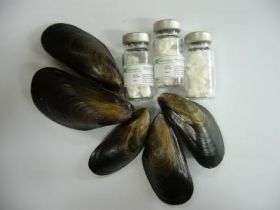Boosting 'mussel' power: New technique for making key marine mussel protein

Researchers in Korea report development of a way to double production of a sticky protein from marine mussels destined for use as an antibacterial coating to prevent life-threatening infections in medical implants. The coating, produced by genetically-engineered bacteria, could cut medical costs and improve implant safety, the researchers say. Their study is scheduled for the June 6 issue of ACS’ Biotechnology Progress.
Bacterial infection of medical implants, such as cardiac stents and dialysis tubing, threatens thousands of people each year and is a major medical challenge due to the emergence of antibiotic-resistant bacteria. Several research groups are working on long-lasting, germ-fighting coatings from mussel proteins, but production of these coatings is inefficient and expensive.
Hyung Joon Cha and colleagues previously developed a way to use genetically engineered E. coli bacteria to produce mussel adhesive proteins. Now they report adding a new gene for producing Vitreoscilla hemoglobin (VHb), a substance that boosts production of proteins under low-oxygen conditions. Adding the VHb gene to the engineered E. coli doubled the amount of mussel proteins produced, which could lead to more cost-effective coatings, the researchers say.
Source: American Chemical Society















